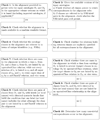Towards valid and reusable reference alignments - ten basic quality checks for ontology alignments and their application to three different reference data sets
- PMID: 22541595
- PMCID: PMC3337267
- DOI: 10.1186/2041-1480-3-S1-S4
Towards valid and reusable reference alignments - ten basic quality checks for ontology alignments and their application to three different reference data sets
Abstract
Identifying relationships between hitherto unrelated entities in different ontologies is the key task of ontology alignment. An alignment is either manually created by domain experts or automatically by an alignment system. In recent years, several alignment systems have been made available, each using its own set of methods for relation detection. To evaluate and compare these systems, typically a manually created alignment is used, the so-called reference alignment. Based on our experience with several of these reference alignments we derived requirements and translated them into simple quality checks to ensure the alignments' validity and also their reusability. In this article, these quality checks are applied to a standard reference alignment in the biomedical domain, the Ontology Alignment Evaluation Initiative Anatomy track reference alignment, and two more recent data sets covering multiple domains, including but not restricted to anatomy and biology.
Figures

Similar articles
-
Experiences from the anatomy track in the ontology alignment evaluation initiative.J Biomed Semantics. 2017 Dec 4;8(1):56. doi: 10.1186/s13326-017-0166-5. J Biomed Semantics. 2017. PMID: 29202830 Free PMC article. Review.
-
Matching disease and phenotype ontologies in the ontology alignment evaluation initiative.J Biomed Semantics. 2017 Dec 2;8(1):55. doi: 10.1186/s13326-017-0162-9. J Biomed Semantics. 2017. PMID: 29197409 Free PMC article.
-
Alignment of multiple ontologies of anatomy: deriving indirect mappings from direct mappings to a reference.AMIA Annu Symp Proc. 2005;2005:864-8. AMIA Annu Symp Proc. 2005. PMID: 16779163 Free PMC article.
-
MICAN: a protein structure alignment algorithm that can handle Multiple-chains, Inverse alignments, C(α) only models, Alternative alignments, and Non-sequential alignments.BMC Bioinformatics. 2013 Jan 18;14:24. doi: 10.1186/1471-2105-14-24. BMC Bioinformatics. 2013. PMID: 23331634 Free PMC article.
-
Ontology Alignment Repair through Modularization and Confidence-Based Heuristics.PLoS One. 2015 Dec 28;10(12):e0144807. doi: 10.1371/journal.pone.0144807. eCollection 2015. PLoS One. 2015. PMID: 26710335 Free PMC article.
Cited by
-
A unified approach for debugging is-a structure and mappings in networked taxonomies.J Biomed Semantics. 2013 Mar 31;4(1):10. doi: 10.1186/2041-1480-4-10. J Biomed Semantics. 2013. PMID: 23548155 Free PMC article.
-
Selected papers from the 14th Annual Bio-Ontologies Special Interest Group Meeting.J Biomed Semantics. 2012 Apr 24;3 Suppl 1(Suppl 1):I1. doi: 10.1186/2041-1480-3-S1-I1. J Biomed Semantics. 2012. PMID: 22541591 Free PMC article.
-
Experiences from the anatomy track in the ontology alignment evaluation initiative.J Biomed Semantics. 2017 Dec 4;8(1):56. doi: 10.1186/s13326-017-0166-5. J Biomed Semantics. 2017. PMID: 29202830 Free PMC article. Review.
References
-
- Euzenat J, Shvaiko P. Ontology Matching. Springer; 2007.
-
- Jiménez-Ruiz E, Cuenca Grau B. LogMap: logic-based and scalable ontology matching. ISWC 2011 – Proceedings of the 10th International Semantic Web Conference, Bonn, Germany. 2011. pp. 273–288. - PubMed
-
- Cruz IF, Antonelli FP, Stroe C. Efficient selection of mappings and automatic quality-driven combination of matching methods. Proceedings of the 4th International Workshop on Ontology Matching, collocated with the 8th International Semantic Web Conference, Chantilly, Virginia, USA. 2009.
-
- Mascardi V, Locoro A, Rosso P. Automatic ontology matching via upper ontologies: a systematic evaluation. IEEE Transactions on Knowledge and Data Engineering. 2010;22(5):609–623.
-
- Jain P, Hitzler P, Sheth A, Verma K, Yeh PZ. Ontology alignment for Linked Open Data. ISWC 2010 – Proceedings of the 9th International Semantic Web Conference, Shanghai, China. 2010. pp. 402–417. - PubMed
LinkOut - more resources
Full Text Sources

